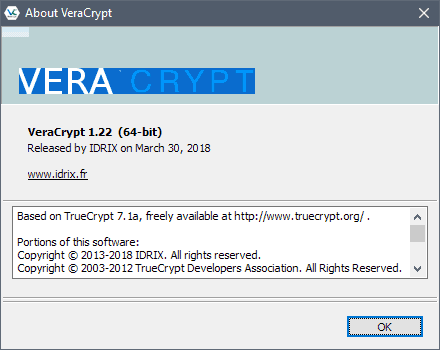VeraCrypt 1.22 is a new version of the popular cross-platform encryption software that parent company Idrassi established as the primary unofficial successor of the encryption software TrueCrypt.
TrueCrypt development ended under mysterious circumstances in 2014. The developers published a message on the project's website and as part of setup that stated that TrueCrypt was not secure to use.
An audit in two parts -- see the article on the results of the first and second part of the audit -- concluded that TrueCrypt had no backdoors but that it had some vulnerabilities.
Programs based on TrueCrypt launched soon after the end of TrueCrypt, and TrueCrypt users started to switch to programs such CipherShed, VeraCrypt and other TrueCrypt alternatives.
VeraCrypt 1.22

VeraCrypt is based on TrueCrypt code and one focus of development was to resolve any security issue that might be in the code. The developers released several security updates, VeraCrypt 1.15, VeraCrypt 1.17 and VeraCrypt 1.18 which resolved TrueCrypt vulnerabilities or other security issues.
VeraCrypt 1.22 is the first update of the software program in 2018. The last update dates back to July 2017.
VeraCrypt requires manual updating as the software program does not support update checks or automatic updates.
You need to head over to the project's website and download the new version for your operating system to update it manually. Windows users may download the installer or a portable version. It may be necessary to restart the system to load the updated VeraCrypt driver on the system.
So, what is new?
Two changes are beneficial to all supported operating systems (Windows, Linux and Mac OS X):
- Kuznyechik cipher implementation speed up (up to the factor 2)
- 5 new cascades of cipher algorithms: Camellia-Kuznyechik, Camellia-Serpent, Kuznyechik-AES, Kuznyechik-Serpent-Camellia and Kuznyechik-Twofish. These add more options to VeraCrypt's multiple encryption support (the use of multiple encryption algorithms)
The Windows version of VeraCrypt received the bulk of improvements, fixes and updates. The bulk of changes fix issues that affected some machines running Windows.
Some examples: the new version fixes an issue that caused the hidden operating system to fail to load on some machines, the incorrect parameter error during the mounting of volumes on select machines, and a rare case of applications freezing during mount and unmount operations.
One new option implemented for Windows versions of VeraCrypt is support for blocking the TRIM command for system encryption on SSD drives, and an option to enable TRIM support for non-system SSD drives.
You can check out the full list of changes on the official project website.



0 Comments